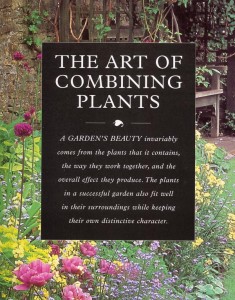Having long believed that good plant combinations are a key to successful planting design, I was pleased to get a copy of The Encyclopedia of planting combinations by Tony Lord and Andrew Lawson (Mitchell Beazley, 2005). They are both expert photographers and Tony Lord, who wrote the text, is a former Gardens Advisor to the UK National Trust. Unsurprisingly, the photographs are excellent – if not quite as excellent as one might have expected. Disappointingly, most of the text is about the individual plants. Since there are many books on individual plants, this could have been omitted. The plant descriptions are followed by remarks on plant combinations and, as one might expect from a pair of photographers, they have a good eye for line, colour and texture.
The most surprising thing about the book is the appalling standard of the introductory section on ‘The art of combining plants’. It reveals the author to have no understanding of garden design as a fine art and somewhat reminded me of books written in the 1920s. Take the opening statement as an example: ‘A garden’s beauty invariably comes from the plants that it contains, the way they work together, and the overall effect they produce’. Does this apply to the Alhambra, to Versailles, to the Taj Mahal or to Rousham? Of course not. A garden is a composition of five elements: landform, vegetation, structures, water and paving. If one element is strong and the other four are weak you will not have a truly great garden.
After this blinkered introduction, the first sentence is ‘Making a successful garden is a question of balancing what is already there with what is required of the plot’. But what IS ‘required of the plot’. The author does not say. The second section (p.13) opens with the sentence ‘Once any hard landscaping is in place, selection of the plants can begin’. Goodness gracious me! You should not employ a gardener when you want your central heating fixed – and you should not employ a horticulturalist when you want a design for your garden. Similarly, the UK National Trust should employ horticulturalists for horticultural advice and garden designers as gardens advisors.


Ouch! Your blog entry sounds a bit grumpy. I understand your point that all the elements of garden design work to create an extraordinary garden, but surely the plants play a key role. Good design doesn’t follow a formula. And quite honestly, I have seen some great garden designs from people that aren’t formally trained horticulturalists. Come to think of it, I visited Barnsley House this past summer and I would venture to bet that the garden was more inspirational when Rosemary Verey tended to it. And if I am not mistaken, it is being tended by trained Horticulturalists today.
My point is not to be disrespectful to Horticulturalists for whom I have great admiration. But I compelled to defend the ordinary folks that may not have formal training, but most definitely understand design.
Excellent blog post. It got my attention. Thank you.
Yes of course: (1) I am a bit grumpy (2)many gardens depend on imaginative horticulture – but many do not (3) many of the best gardens were made by owner-designers who did not have a design training (4) I admire photographers, horticulturalists and most people with skills of a high order – but they are best when doing what they are best at doing.